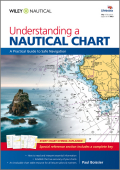
Understanding a nautical chart: a practical guide to safe navigation
Boissier, Paul
A handy guide to making sense of a nautical chart Whether they are paper or electronic, charts are the most fundamental navigational tool. Making the best use of them requires a great understanding of symbols and abbreviations, as well as an awareness of the limits of accuracy in positions and soundings. Understanding a Nautical Chart not only helps you to read a chart, it allows you tounderstand that information and use it to navigate safely. Learning the abbreviations and symbols are critical to anybody using a chart and before you can use one, you must know them or at have easy access to the definitions, all of which are included in a full copy of the key to UKHO charts (Chart 5011). Explains how to establish the accuracy of charts to allow you to navigate with confidence and safety Written by a former Royal Navy Deputy Commander in Chief, Paul Boissier Includes a full copy of the key to UKHO chart symbols (Chart 5011). The chart information included is presented in the following sections: General Chart Number, Title, Marginal Notes, Positions, Distances, Directions, Compass Topography Natural Features, Cultural Features, Landmarks, Ports, Topographic Terms HydrographyTides, Currents, Depths, Nature of the Seabed, Rocks, Wrecks, Obstructions, Offshore Installations, Tracks, Routes Areas, Limits, Hydrographic Terms Aids and ServicesLights, Buoys, Beacons, Fog Signals, Radar, Radio, Electronic Position-Fixing Systems, Services, Small Craft Facilities Alphabetical IndexIndex of Abbreviations, International Abbreviations, List of Descriptors, IALA Maritime Buoyage System Chart 5011 INDICE: Chapter 1 What is a Chart? Chapter 2 A Chart is Never 100% Accurate. Chapter 3 What the Chart-Maker Does for Us. Chapter 4 Other Relevant Documentation. Chapter 5 How to Use a Chart. Chapter 6 Orientation. Chapter 7 The Basics (and Where to Find Them). Chapter 8 Depth and Elevations. Chapter 9 Landmarks, Light and Coastal Features. Chapter 10 Dangers: Wrecks, Rocks and Obstructions. Chapter 11 Navigation Restrictions and Limits. Chapter 12 Radar and Radio. Chapter 13 Tides, Tidal Streams and Currents. Chapter 14 Small Craft Features. Chapter 15 Other Charting Authorities. Chapter 16 GPS. Chapter 17 Digital Charting.
- ISBN: 978-0-470-74913-5
- Editorial: John Wiley & Sons
- Encuadernacion: Rústica
- Páginas: 160
- Fecha Publicación: 15/04/2011
- Nº Volúmenes: 1
- Idioma: Inglés
